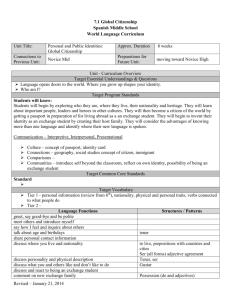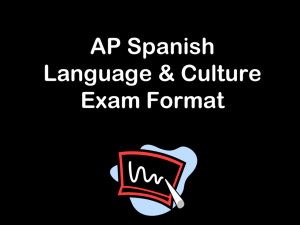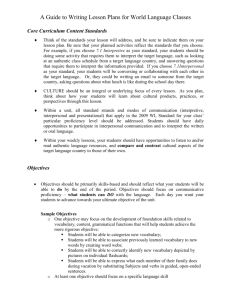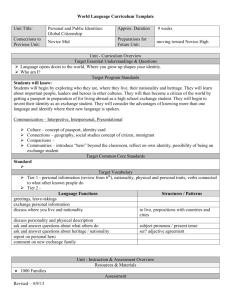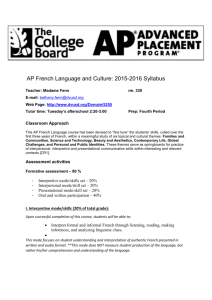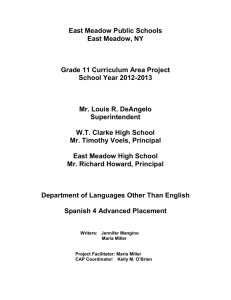Summary-New AP
advertisement
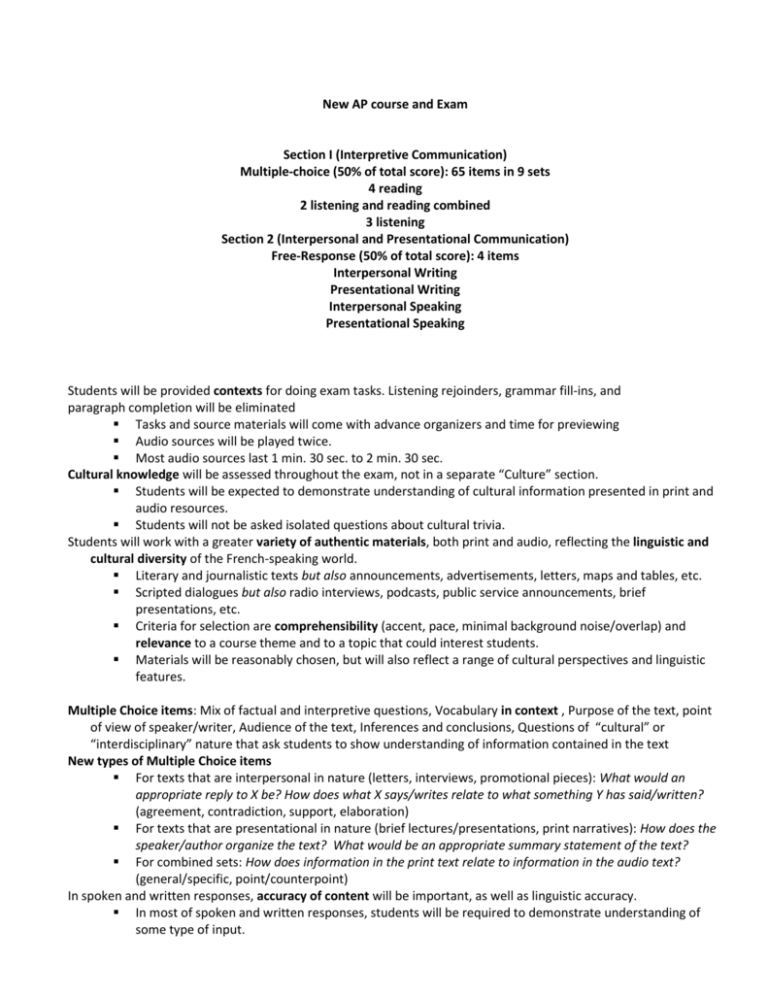
New AP course and Exam Section I (Interpretive Communication) Multiple-choice (50% of total score): 65 items in 9 sets 4 reading 2 listening and reading combined 3 listening Section 2 (Interpersonal and Presentational Communication) Free-Response (50% of total score): 4 items Interpersonal Writing Presentational Writing Interpersonal Speaking Presentational Speaking Students will be provided contexts for doing exam tasks. Listening rejoinders, grammar fill-ins, and paragraph completion will be eliminated Tasks and source materials will come with advance organizers and time for previewing Audio sources will be played twice. Most audio sources last 1 min. 30 sec. to 2 min. 30 sec. Cultural knowledge will be assessed throughout the exam, not in a separate “Culture” section. Students will be expected to demonstrate understanding of cultural information presented in print and audio resources. Students will not be asked isolated questions about cultural trivia. Students will work with a greater variety of authentic materials, both print and audio, reflecting the linguistic and cultural diversity of the French-speaking world. Literary and journalistic texts but also announcements, advertisements, letters, maps and tables, etc. Scripted dialogues but also radio interviews, podcasts, public service announcements, brief presentations, etc. Criteria for selection are comprehensibility (accent, pace, minimal background noise/overlap) and relevance to a course theme and to a topic that could interest students. Materials will be reasonably chosen, but will also reflect a range of cultural perspectives and linguistic features. Multiple Choice items: Mix of factual and interpretive questions, Vocabulary in context , Purpose of the text, point of view of speaker/writer, Audience of the text, Inferences and conclusions, Questions of “cultural” or “interdisciplinary” nature that ask students to show understanding of information contained in the text New types of Multiple Choice items For texts that are interpersonal in nature (letters, interviews, promotional pieces): What would an appropriate reply to X be? How does what X says/writes relate to what something Y has said/written? (agreement, contradiction, support, elaboration) For texts that are presentational in nature (brief lectures/presentations, print narratives): How does the speaker/author organize the text? What would be an appropriate summary statement of the text? For combined sets: How does information in the print text relate to information in the audio text? (general/specific, point/counterpoint) In spoken and written responses, accuracy of content will be important, as well as linguistic accuracy. In most of spoken and written responses, students will be required to demonstrate understanding of some type of input. Free Response Item 1: E-mail Reply (Interpersonal Writing) Directions (in English and French, printed side-by-side): You will write a reply to an e-mail message. You have 15 minutes to read the message and write your reply. Your reply should include a greeting and a closing as well as respond to all the questions and requests in the message. In your reply, you should also ask for more details about something mentioned in the message. Stimulus: A formal e-mail message (i.e. from a business, organization, university) presented as an e-mail message window; contains a greeting and a closing; contains a request for clarification, elaboration, or explanation by the student; contains two questions that cannot be answered yes/no. Free Response Item 2: Persuasive Essay (Presentational Writing) Stimuli: (1) A print source (journalistic article or literary text) that presents a clear opinion on the topic; opinion is different from that of the audio source (authentic source, may be excerpted). (2) A map with text, a chart or a table that presents information on the topic – this source doesn’t have to present an opinion (authentic source) (3) An audio source (interview, report, or announcement) that presents a clear opinion on the topic that is different from the opinion in the print source (authentic source, may be excerpted). Free Response Item 3: Conversation (Interpersonal Speaking) Directions (in English followed by French): You will participate in a conversation. First, you will have 1 minute to read a preview of the conversation, including an outline of each turn in the conversation. Afterward, the conversation will begin, following the outline. Each time it is your turn to speak, you will have 20 seconds to record your response. You should participate in the conversation as fully and appropriately as possible. Stimulus: Outline of a conversation in French that contains a description of each of five utterances from the interlocutor (the recording) and each of five utterances from the student; descriptions in the outline focus on communicative functions (e.g. tell your friend what happened, make a suggestion, offer a solution, excuse yourself and say goodbye). Free response Item 4: Cultural Comparison: (Presentational Speaking) Directions (in English followed by [French/German]): You will make an oral presentation to your class on a specific topic. You will have 3 minutes to read the topic and prepare your presentation. Then you will have 2 minutes to record your presentation. In your presentation, compare your own community to an area of the French-speaking world with which you are familiar. You should demonstrate your understanding of cultural features of the French-speaking world. You should also organize your presentation clearly. Stimulus: There is no stimulus, only a prompt. The goals of this task are for the students to speak first about themselves and their communities (using description or explanation) and then speak of an area of the [French/German]speaking world about which they’ve learned something or have some personal experience (using comparison). Students are encouraged to cite examples from materials they’ve read, viewed, and listened to, personal experiences and observations.

